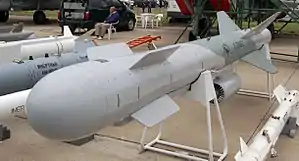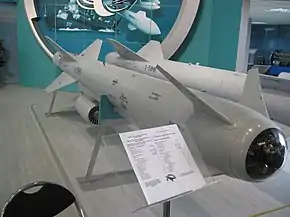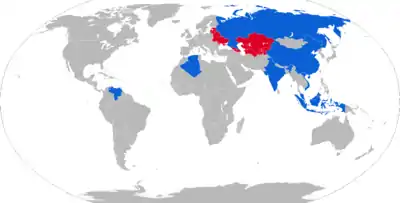Kh-59
The Kh-59 Ovod (Russian: Х-59 Овод 'Gadfly'; AS-13 'Kingbolt') is a Russian TV-guided cruise missile with a two-stage solid-fuel propulsion system and 200 km range. The Kh-59M Ovod-M (AS-18 'Kazoo') is a variant with a bigger warhead and turbojet engine. It is primarily a land-attack missile but the Kh-59MK variant targets ships.[4]
| Kh-59 Ovod (NATO reporting name: AS-13 'Kingbolt') Kh-59M Ovod-M (AS-18 'Kazoo') | |
|---|---|
 Kh-59MK at MAKS 2009 | |
| Type | Cruise missile Air-launched cruise missile Air-to-surface missile Anti-ship missile Land-attack missile |
| Place of origin | Soviet Union/Russia |
| Service history | |
| In service | 1980-current |
| Used by | Russia, China, India, Algeria |
| Production history | |
| Designer | MKB Raduga |
| Manufacturer | Tactical Missiles Corporation |
| Specifications | |
| Mass | 930 kg (2,050 lb)[1] |
| Length | 570 cm (220 in)[1] |
| Diameter | 38.0 cm (15.0 in)[1] |
| Warhead | Cluster or shaped-charge fragmentation[1] |
| Warhead weight | 320 kg (705 lb)[2] |
| Engine | Kh-59: two-stage rocket Kh-59ME: rocket then R95TP-300[3] turbojet/turbofan |
| Wingspan | 130 cm (51.2 in)[1] |
Operational range | Kh-59ME (export): 115 km (62 nmi)[1] Kh-59ME: 200 km (110 nmi) Kh-59MK: 285 km (150 nmi) Kh-59MK2: 550 km (300 nmi) |
| Maximum speed | Mach 0.72-0.88[1] |
Guidance system | inertial guidance (then TV guidance), millimeter wave active radar seeker (Kh-59MK, Kh-59MK2 land attack version)[4] |
Launch platform | Kh-59ME: Su-30MK[1] Kh-59: Su-24M, MiG-27, Su-17M3/22M4, HAL Tejas, Su-25 and Su-30[5] Kh-59MK2: Su-57[6] |
Development
The initial design was based on the Raduga Kh-58 (AS-11 'Kilter'), but it had to be abandoned because the missile speed was too high for visual target acquisition.
Raduga OKB developed the Kh-59 in the 1970s as a longer ranged version of the Kh-25 (AS-10 'Karen'),[7] as a precision stand-off weapon for the Su-24M and late-model MiG-27's.[5] The electro-optical sensors for this and other weapons such as the Kh-29 (AS-14 'Kedge') and KAB-500 Kr bombs were developed by S A Zverev NPO in Krasnogorsk.[7]
It is believed that development of the Kh-59M started in the 1980s.[4] Details of the Kh-59M were first revealed in the early 1990s.[4]
Design
The original Kh-59 is propelled by a solid fuel engine, and incorporates a solid fuel accelerator in the tail. The folding stabilizers are located in the front of the missile, with wings and rudder in the rear. The Kh-59 cruises at an altitude of about 7 meters above water or 100–1,000 metres (330–3,280 ft) above ground with the help of a radar altimeter. It can be launched at speeds of 600 to 1,000 km/h (370 to 620 mph) at altitudes of 0.2 to 11 kilometres (660 to 36,090 ft) and has a CEP of 2 to 3 meters.[2] It is carried on an AKU-58-1 launch pylon.[5]
The Kh-59ME has an external turbofan engine below the body just forward of the rear wings, but retains the powder-fuel accelerator. It also has a dual guidance system consisting of an inertial guidance system to guide it into the target area and a television system to guide it to the target itself.[1]
The 36MT turbofan engine developed for the Kh-59M class of missiles is manufactured by NPO Saturn of Russia.[8]
Target coordinates are fed into the missile before launch, and the initial flight phase is conducted under inertial guidance. At a distance of 10 km from the target the television guidance system is activated. An operator aboard the aircraft visually identifies the target and locks the missile onto it.
Operational history
Although the original Kh-59 could be carried by the MiG-27, Su-17M3, Su-22M4, Su-24M, Su-25 and Su-30 family if they carried an APK-9 datalink pod, it was only fielded on the Su-24M in Russian service.[5] From 2008–2015, Russia delivered some 200 Kh-59 missiles to China for use on the Su-30MK2; deliveries may have included both Kh-59MK and Kh-59MK2 versions. The Kh-59MK2 has been test-fired by a Su-57 stealth fighter, during its 2018 Syrian deployment.[6]
Variants


- Kh-59 (AS-13 'Kingbolt') - original version with dual solid-fuel rocket engines. First shown in 1991; exported as Kh-59 or Kh-59E.[7]
- Kh-59M (AS-18 'Kazoo') - adds turbojet engine and larger warhead. Range 115 km.[1]
- Kh-59ME - 200 km-range variant offered for export in 1999.[4]
- Kh-59MK - 285 km-range anti-shipping variant with turbofan engine and ARGS-59 active radar seeker.[4][10]
- Kh-59MK2 - land attack variant of Kh-59MK (fire-and-forget),[4] equipped with either a 320 kg penetrating or 285 kg (628 lb) pellet warhead.[11]
- Kh-59M2 - Kh-59M/Kh-59MK with new TV/IIR seekers, reported in 2004.[4]
- Kh-20 - possible name for nuclear-tipped variant carried by Su-27 family.[4]
- Kh-59L - laser-guided variant that was developed.[5]
- Kh-59T - TV guided instead laser guidance variant.
- Kh-59MK2 (AS-22) - stealth standoff version, with range of 290 km, warhead weight up to 320 kg and launch weight up to 770 kg. First unveiled at MAKS 2015.[12] [13]
Proposed development options for the Kh-59M/ME have included alternative payloads (including cluster munitions) but their current development status is unclear.[5][14]
Operators

Current operators
See also
- AGM-130 TV-guided penetration missile
- AGM-84E/H/K Standoff Land Attack Missile
- AGM-62 Walleye II - TV-guided glide bomb with 83 km range
- Kh-37 variant of Kh-35U (AS-20 'Kayak') - 145 kg warhead, 250 km range
- Kh-58 (AS-11 'Kilter') - Raduga anti-radar missile, 120 km range
- Kh-35 (AS-20 'Kayak')
Notes
- Rosoboronexport Air Force Department and Media & PR Service, AEROSPACE SYSTEMS export catalogue (PDF), Rosoboronexport State Corporation, p. 124, archived from the original (PDF) on 30 October 2007
- "Raduga Kh-59 (AS-13 Kingbolt) and Kh-59M (AS-18 Kazoo)". Archived from the original on 1 January 2009. Retrieved 22 December 2008.
- http://www.amntksoyuz.ru/en/
- "Kh-59M, Kh-59ME Ovod-M (AS-18 'Kazoo')", Jane's Air-Launched Weapons, 3 December 2010, archived from the original on 11 August 2011, retrieved 28 April 2011
- Kh-59 Ovod (AS-13 'Kingbolt'), 24 October 2007, retrieved 3 February 2009
- "Russian Su-57 reportedly fired cutting-edge Kh-59Mk2 cruise missile during tests in Syria". ruaviation.com. 29 May 2018. Retrieved 21 July 2019.
- "Kh-59 (AS-13 'Kingbolt'/Ovod)", Jane's Strategic Weapon Systems, 9 September 2008, retrieved 3 February 2009
- "Saturn military engines for unmanned aerial vehicles". NPO Saturn website. Retrieved 28 April 2011.
- "Kh-59MK extended-range Air-to-Surface Missile". Rosoboronexport.
- "Kh-59MK2 Air-to-Surface Guided Missile". Rosoboronexport.
- "Russian Stealth Ship Killers Debut at MAKS 2015". defense-update.com. 30 August 2015. Retrieved 21 July 2019.
- https://imgur.com/2C0kUW1. Missing or empty
|title=(help) - Wiebe, Virgil; Titus Peachey (2000). "Clusters of Death". The Mennonite Central Committee Global Report on Cluster Bomb Production and Use. Mennonite Central Committee. Retrieved 28 April 2011.
Also known as the Kh-59M Ovod-M, the AS-18 is modernized version of AS-13 Kingbolt ... The warhead can be either a 705-lb high explosive or 617-lb cluster submunitions.
- http://armstrade.sipri.org/armstrade/page/trade_register.php
- 2011 Annual Report of Tactical Missile Corporation, "Archived copy". Archived from the original on 21 August 2012. Retrieved 31 July 2013.CS1 maint: archived copy as title (link)
References
- Gordon, Yefim (2004), Soviet/Russian Aircraft Weapons Since World War Two, Hinckley, England: Midland Publishing, ISBN 1-85780-188-1
